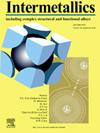Microstructure and mechanical properties of CoCrNi/GH99 medium entropy alloy brazed joints: Formation of medium entropy brazing seam
IF 4.3
2区 材料科学
Q2 CHEMISTRY, PHYSICAL
引用次数: 0
Abstract
Brazing CoCrNi to GH99 is of great significance for manufacturing high-strength and lightweight structural components in thermal protection systems. BNi-5a amorphous filler was used to braze CoCrNi to GH99 in this study, and medium entropy brazing seams were obtained. The typical CoCrNi/BNi-5a/GH99 joint is composed of the brazing seam and diffusion zones on both sides of substrates. The main component of the brazing seam is a γ (Ni, Cr) solid solution, with CrB and borides on CoCrNi side and GH99 side, respectively. Increasing the brazing temperature and prolonging the holding time can promote atomic diffusion and form more precipitates in diffusion zones on both sides, but the microstructure of the joints tends to homogenize under excessively high temperature or longer holding time. The joints obtained at the parameter of 1210 °C/10 min reach the maximum shear strength of 557 MPa. The brazing seam has outstanding effects similar to those of medium and high entropy alloys, leading to excellent mechanical properties. Most joints exhibit a mixed mode of cleavage fracture and microvoid coalescence fracture, and fracture occurs at the brazing seam. EBSD analysis reveals that the deformation of CoCrNi base material is greater than that of the brazing seam after shear test. ∑3 twins and low-angle grain boundaries are formed in CoCrNi substrate, and cracks propagate along the grain boundaries in the brazing seam.
求助全文
约1分钟内获得全文
求助全文
来源期刊

Intermetallics
工程技术-材料科学:综合
CiteScore
7.80
自引率
9.10%
发文量
291
审稿时长
37 days
期刊介绍:
This journal is a platform for publishing innovative research and overviews for advancing our understanding of the structure, property, and functionality of complex metallic alloys, including intermetallics, metallic glasses, and high entropy alloys.
The journal reports the science and engineering of metallic materials in the following aspects:
Theories and experiments which address the relationship between property and structure in all length scales.
Physical modeling and numerical simulations which provide a comprehensive understanding of experimental observations.
Stimulated methodologies to characterize the structure and chemistry of materials that correlate the properties.
Technological applications resulting from the understanding of property-structure relationship in materials.
Novel and cutting-edge results warranting rapid communication.
The journal also publishes special issues on selected topics and overviews by invitation only.
 求助内容:
求助内容: 应助结果提醒方式:
应助结果提醒方式:


